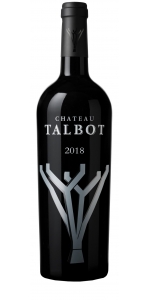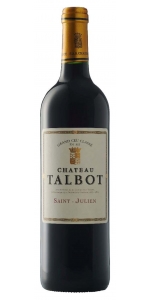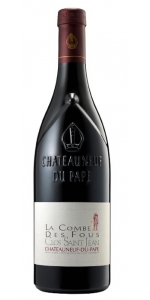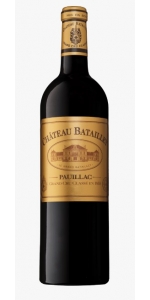Chateau Beard La Chapelle Saint Emilion Grand Cru 2012
| Country: | France |
| Region: | Bordeaux |
| Winery: | Beard La Chapelle |
| Grape Type: | Merlot |
| Organic: | Yes |
| Vintage: | 2012 |
| Bottle Size: | 750 ml |
Chateau Talbot Saint-Julien Grand Cru Classe is made from 69 % Cabernet Sauvignon, 26 % Merlot, 5 % Petit Verdot.
The wine presents a delicate and captivating nose of black fruits, fresh tobacco, peppermint and floral nuances. Ripe and juicy fruit flavors of black currants on the palate with well integrated velvety tannins and a beautiful refreshing acidity to the long finish.
For the 2018 vintage, a special packaging with a unique silkscreen printing bottle was created to mark the 100th anniversary of the Cordier Family's acquisition of Chateau Talbot
Pair with red meat, roast pork, game meat, poultry, hard cheeses, poached pear.
"Rich aromas of blackcurrant, blackberry, chocolate, tobacco and licorice. Oyster shell, too. It’s full-bodied with firm, well integrated tannins. Polished, silky layers with a long finish. Gorgeous ripe and bright fruit in the center palate. Best in a long time. Try from 2025."
Chateau Talbot Saint-Julien Grand Cru Classe is made from 69 % Cabernet Sauvignon, 26 % Merlot, 5 % Petit Verdot.
The wine presents a delicate and captivating nose of black fruits, fresh tobacco, peppermint and floral nuances. Ripe and juicy fruit flavors of black currants on the palate with well integrated velvety tannins and a beautiful refreshing acidity to the long finish.
For the 2018 vintage, a special packaging with a unique silkscreen printing bottle was created to mark the 100th anniversary of the Cordier Family's acquisition of Chateau Talbot
Pair with red meat, roast pork, game meat, poultry, hard cheeses, poached pear.
"Well-built and rather refined for the vintage, with a deep well of red and black currant paste and plum reduction flavors supported by a deeply inlaid iron note, all of which run the length of the wine. Offers subtle savory, tobacco and singed cedar notes that add range, with a savory echo that leaves a mouthwatering feel in the end. Built to cellar. Cabernet Sauvignon, Merlot and Petit Verdot. Best from 2025 through 2040. - James Molesworth"
- Wine Spectator (March 2022), 95 pts
Landes Grand Heritage Lussac Saint Emilion is made from 100 percent Merlot.
First vintage of this wine was 2010 to pay tribute to the founding father of Chateau des Landes - Paul Lassagne. He gave the family a great legacy of terroir, passion and know-how to craft this great cuvee produced from a selection of the finest grapes that are vinified and aged in 600 liter French oak foudres, just like it was done in the old days. The resulting wine is complex and aromatic offering bold aromas and flavors of dark berries, floral tones, spice, oak and vanilla. The palate is onctuous and powerful, well structured with ripe tannins. Well balanced and a complex finish.
Average age of the Vines: 60 years Yield : 50 hectoliters / hectare. Grape picking: harvest by machine. Vats: Stainless steel thermoregulated and computerized. Fermentation: 45 to 50 days with a final 35°C warm steeping. Winemaking: Malolactic fermentation in new oak barrel. Ageing: 16 months in new French Oak barrels from Allier and Limousin. Annual production: 10,000 bottles. (833 cases)
Fombrauge Saint Emilion is made from 96% Merlot and 4% Cabernet Franc.
Château Fombrauge 2020 has a dark red hue, intense fruit aromas and elegant tannins that offer a generous mouthfeel rarely seen in wine so young.
The nose reveals aromas of cherries, blackberries and raspberries, along with spicy notes.
On the palate, the wine i round, soft and silky. Its deep richness, matched with a nice freshness and a long and mellow finish, make it already a great Château Fombrauge, with a long ageing potential.
Chateau Fombrauge Saint-Emilion Grand Cru's food pairing
Clos Saint-Jean is a 41-hectare estate in Châteauneuf-du-Pape run by brothers Vincent and Pascal Maurel. Considered by many critics and wine-writers as the preeminent estate espousing the modern style of winemaking in Châteauneuf, this cellar is one of the oldest in the region, having been founded in 1900 by the greatgreat-grandfather of Vincent and Pascal, Edmund Tacussel. A short time after its founding and well before the AOP of Chateauneuf-du-Pape was created in 1923, Edmund began bottling estate wines in 1910.
The farming at Clos Saint-Jean is fully sustainable due to the warm and dry climate, which prevents the need for chemical inputs. Instead, Vincent and Pascal employ organic methods for pest control, mainly pheromones, to prevent pests from taking up residence in their vines, a process called amusingly enough in French, confusion sexuelle. The vines tended manually, and harvest is conducted in several passes entirely by hand.
Combe des Fous literally means, the hill of the fool. The hill, in this case, is located in the far southern reach of Le Crau which was left barren for many centuries because the layer of galets was so exceedingly deep that everyone assumed vines could never survive there. The fool in this situation is Edmund Tacussel, the great-great-grandfather of Vincent and Pascal Maruel who planted a Grenache vineyard on this site in 1905. That old-vine Grenache form the heart of this cuvée with a small amount of Syrah, Cinsault and Vaccarèse. La Combe des Fous is only made in the best vintages.
Review:
This has good concentration and energy to the dense core of dark fruit and bitter cherry, with great poise and elegance despite its ripeness (an impressive feat for the vintage). Guided by finely crushed mineral accents and tannins, this reveals pretty high-toned floral notes and leafy tobacco. Grenache, Syrah, Mourvedre, Cinsault, Vaccarese and Muscardin. Drink now through 2032. 900 cases made.
-Wine Spectator 95 Points
Chateau Batailley Grand Cru is made from 78% Cabernet Sauvignon, 19% Merlot, 2% Petit Verdot & 1% Cabernet Franc.
Château Batailley is a winery in the Pauillac appellation of the Bordeaux region of France. The wine produced at the estate was classified as one of eighteen Cinquièmes Crus (Fifth Growths) in the Bordeaux Wine Official Classification of 1855.
Garnet-purple colour. Rich and expressive nose, fruity with notes of spices, smoke and vanilla. On the palate, this wine is supple, round, well balanced, with good acidity, a nice fruitiness and nice notes of leather and cedar. Long elegant finish.
Review:
The 2010 Batailley repeated its magnificent showing when poured at the chateau. It has a detailed bouquet of blackberry and cedar, quite backward and seemingly having advanced lite since | tasted in in April 2016. The palate remains full of tension and brimming with energy, delivering classic cedar and tobacco notes toward the persistent finish. Batailley can produce wines that live many decades, and this is clearly one of them. Tasted at the property. Drink 2020-2050
- Neal Martin Vinous 95 Points
Appellation: Saint- Emilion
Composition: 90% Merlot,7% Cabernet Franc,3% Cabernet Sauvignon
Aging: Ageing is for 12 months.
Tasting Notes: Dark purple in the glass. Aromas of blackcurrant, vanilla and a touch of wood on the nose. At first taste you can tell this wine will take on some age. Rich and layered, but held back due to its youth. Soft tannins blend with black fruit flavors and a touch of mineral on the finish. Drink over the next 7 to 10 years. This vintage is more approachable at an early age then the previous two vintages.
Soil: Limestone-clay on the "côtes" and deep-lying sand on the "pieds de côtes".
Avg Age of Vines: Vines have an average age of 40 years.
Vinification: Grapes are picked by hand and machine, but manually sorted after destemming. The vinification is a traditional with three gentle pumping overs per day and with one or two rack and returns carried out during the period of fermentation. Total time in vat is between 3 to 4 weeks
Awards: 2013 Gilbert & Gaillard Guide - Gold Medal
ituated in the Gironde, in the village of Saint-Laurent-des-Combes, one of the eight communes in the Juridiction of St Emilion which has been classed as an official World Heritage UNESCO site since 1999. The 18 hectare estate of Béard La Chapelle is an Appellation d’Origine Contrôlée Saint Emilion Grand Cru. The Appellation of Grand Cru St Emilion stipulates a planting density of only 5,500 vines per hectare and a maximum yield of 49 hectolitres per hectare.
This yield is one of the lowest in Bordeaux and enforces producers to reduce the production of each vine making the grapes harvested more concentrated in terms of colour, tannins and aromas.
History of the Property
The property of Château Béard La Chapelle has been in the same family for 9 generations and has had two main chapters in its history. In 1980, Richard Moureau took over the vineyards from his parents and built a cellar next to the single vineyard plot “Béard”, the site of an ancient chapel from which the property took its name. He received the following year the « le Chapitre des Honneurs » of Saint Emilion for his 1981 vintage awarded to him by the famous oenologist, Emile Peynaud. In 2006, Richard’s son Franck left his career in journalism to take over the running of the estate.
In 2009 his sister Laurence takes in charge communication and export issues. The estate has grown by a few hectares, vines have been replaced and the density of the vineyards has been increased to 7,600 vines per hectare. The winery has been updated and procedures such as “green harvesting” deleafing, desuckering and removing the superfluous bunches of grapes) have been introduced systematically.
The Vineyards, Terroir and Grapes
There are 18 hectares of vineyards grow in clay and limestone soils on the slopes of St Emilion and deep sand on the base of the slopes. The average age of the vines is 40 years and the density of the vines is 5,500 per hectare for the oldest parcels of vines and 7,600 vines per hectare for all of the plots that have been replanted. Béard La Chapelle is a wine made from the three main grape varieties of the appellation:
- Merlot (90%) : The predominance of Merlot in this wine gives a good aromatic complexity of red and black fruits. The signature of Béard is a floral perfume of rose and violets. The tannins are supple and there is a roundness on the palate with a smooth silky finish.
- Cabernet Franc (7%) and Cabernet Sauvignon (3%) : The Cabernets give spicy notes to the wine and a good structure which helps to give it further ageing potential. Château Béard La Chapelle is a feminine wine of elegance and finesse.According to the type of soil, the vines are grafted with 101.14 root stocks (for the lighter soils), and 3309 (for the deep well draining sands).
Making the Wine
Béard La Chapelle produces 100,000 bottles per year. Franck Moureau is the wine maker and runs the property with the help of two full-time workers (and their wives who work part-time in the vineyards). They have worked for the property for over 20 years.
In addition, seasonal workers are employed for jobs such as the “green harvest” and for deleafing prior to harvest-time. Franck’s sister, Laurence, is in charge of the promotion of the vineyard brand and the development of international sales.
A Year in the Vineyard
Between mid December and mid February when the sap is in the roots of the vine, pruning takes place ; “Guyot simple” (1 branch with 7 buds). In the summer the the excess leaves of the vine are removed to give good aeration and to better expose the bunches of grapes to the sun. A “green harvest” is also carried out to ensure that there are only 7 bunches of grapes per vine. In parallel the vines are treated to protect them from disease but only when absolutely necessary. Alternative practices (such as spraying with an organic adjuvant and use of “intercep” machinery) are being trialled to ensure that Béard La Chapelle is produced as naturally as possible.
Grass is grown in between the vines on alternate rows which allows any excess water to be absorbed. In addition alternate rows are cultivated to encourage microbial life and to encourage roots to delve deep.
A Year in the Cellar
The winery has a capacity of 2,000 hectolitres and the stainless steel vats are thermo-regulated. The equipment in the winery includes a pneumatic press for gentle pressing, a destemming machine and a sorting table. The underground ageing cellar holds 300 french oak “barriques” from five different coopers (medium toast). At the time of harvest after destemming, the grapes are sorted by hand on the sorting table. A cold soak is carried out during a period of five days at 7° before fermentation begins. The vinification is traditional with four gentle pumping overs per day and with one rack and returns carried out during the period of fermentation. The total time in vat is between 3 to 4 weeks. The wine is aged for 12 months, in one third new barrels, one third barrels of one “wine” and one third barrels of two “wines”.
The wine in barrel is racked on average four times during its ageing depending on the vintage. At the end of ageing, the different lots of the wine are blended before being fined with egg whites. The wine is bottled at the property.
- back
Laurent-Perrier Grand Siecle No. 26 is a blend of 58% Chardonnay, 42% Pinot Noir
white gold in color with delicate and persistent bubbles, Grand Siecle No. 26 offers a very complex nose which mixes honeysuckle, lemon, clementine and fresh butter aromas, followed by notes of hazelnut and a touch of honey. The feel in the mouth is very delicate and fresh with candied lemon and fresh hazelnut aromas. The palate is silky and mineral with notes of honeysuckle, flaked almonds and clementine.
It pairs with high quality produce and refined dishes, including shellfish, noble fish and white meats such as Thai style langoustine tartare and fine roasted poultry.
- 3 exceptional years chosen for their complementarity among the rare Laurent‑Perrier vintages.
- A majority of Chardonnay complemented by Pinot Noir from a maximum of 11 Grands Crus out of the 319 Crus in the Champagne region.
- Aged for 10 years on the lees for the bottle format and a few more years for the magnum format.
Vintage in Champagne is usually synonymous with excellence for Prestige Cuvées. Contrarily, Laurent‑Perrier believes that only the art of assemblage can offer what nature can never provide, that is, the perfect year.
The expression of the perfect year is that of a great champagne wine that has long ageing potential and over time develops depth, intensity and aromatic complexity yet retains its freshness and vibrancy.
Since 1959, Grand Siècle has been revealed only 26 times in bottle format and 23 times in magnum.
The « Grand Siècle » (Great Century) is the name given to one of the most prosperous periods (17th century) in the history of France known for the capacity of man, through his works, to create what nature cannot. Louis XIVth, known as the « Sun King », by creating the « Château de Versailles » and its gardens, was the architect of this model of harmony, balance and perfection.
The symmetry and perspective of the « Jardins à la française », the capacity to grow Mediterranean fruits (especially Oranges inside the « Orangerie ») in such a Northern climate, creating the Grand Canal, the fountains and ponds with no nearby rivers are many illustrations of this ability of man to sublimate natural elements. The name of Grand Siècle was chosen for Laurent‑Perrier’s Prestige Cuvée based on this common vision to reach a perfection that Nature, on its own, cannot provide.
Review:
This is really something. Electric on the palate. The aromas are so complex with sliced fresh and dried ginger, subtle pie crust, tarte tatin and hints of nutmeg with some salted caramel. Toasted bread, too. Always subtle. The palate is full- to medium-bodied yet hemmed-in with a freshness and balance that draws you back. Savory and vibrant. It's full of energy. Spectacular. Fascinating. Symphonic blend of 2012, 2008 and 2007. 65% of the 2012, 25% of the 2008 and 10% of the 2007. Eight grand cru. Chardonnay 58% and 42% pinot noir. Disgorged February 2023. 10 years on the lees. 7g/L dosage.
-James Suckling 100 Points
Long Shadows Poets Leap Riesling is made from 100 percent Riesling.
Tasting Notes: The Poet's Leap Riesling offers aromas of white peach, jasmine, Thai basil and nutmeg. Flavors of ripe melon, apricot and an appealing minerality continue across the palate. An underlying hint of honey sweetness is balanced by a streak of bright acidity that provides a long, clean finish.












